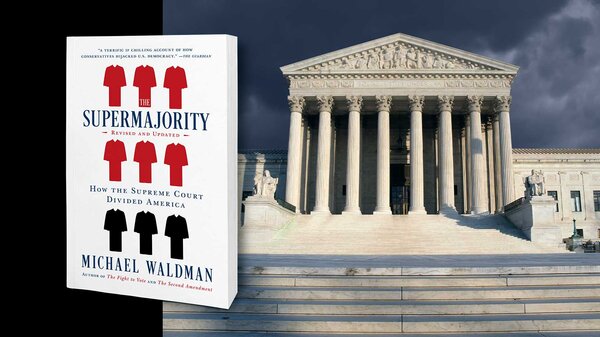I’m very proud that on Tuesday, Simon & Schuster published my new book, The Supermajority. It tells the story of the U.S. Supreme Court’s lurch to the right and why it’s bad for the country. I wanted to draw on the lessons of history to understand how we got here and what will happen next. I wanted to make the case that robust debate about the Supreme Court is not a transgression — it is the way the country always has responded when the justices go too far. And I wanted to stir people to action.
As always, I learned a lot in writing it.
One thing that became clear: we’ve been here before. Most of the time the Court reflects the public consensus. But a few times the Court has been unduly activist, or ideological, or partisan, and that has provoked a fierce backlash. Those court fights have been at the center of politics. They have been intense and partisan, and they have shaped the country.
The 1857 Dred Scott ruling that Black people could never be U.S. citizens, for example. It was a moral atrocity, of course. I knew it helped lead to the Civil War, but I hadn’t realized just how much it shaped politics. Abraham Lincoln’s attacks on it led to his election to the presidency and the rise of the Republican Party. Historians have chided him for accusing the justices of working with President James Buchanan and pro-slavery politicians — but it turns out even conspiracy-minded Honest Abe underestimated how much collusion was actually going on.
Similarly, I hadn’t realized the big issue in Theodore Roosevelt’s fabled 1912 “Bull Moose” presidential campaign was his attack on the reactionary justices and their rulings in cases like Lochner v. New York. The brief moment of the Warren Court, when the Court was ahead of the country, bedazzled many later generations of liberals even though, for most of our history, “judicial restraint” was a progressive battle cry. And we are still living through the conservative backlash to the Warren Court era.
I became increasingly determined to shake the complacency of my fellow liberals. We need to disenthrall ourselves — to recognize that justices are not wizards (even though they wear robes), nor religious figures, but government officials. Very, very powerful government officials, with lifetime appointments, backed by a huge dark money machine.
A second thing that became clear over the year I wrote the book: this was not just a highly consequential term, but a really noisy one. The Dobbs ruling on abortion leaked, we learned just how involved Ginni Thomas was in the “Stop the Steal” movement that led to the January 6 insurrection, and the justices started attacking each other in public. An observer once likened an earlier Court to “nine scorpions in a bottle.” Now the scorpions are crawling all over the table. All this has helped bring about the collapse of public confidence in the Court, at a moment when its right-wing leaders are aiming to make big, bold moves. A recipe for further conflict.
I’m encouraged by one more thing. So many people despair when they think about the Court. There is, as Dahlia Lithwick of Slate puts it, a learned helplessness. In fact, there are things we can do. The conclusion of the book endorses term limits (which are hugely popular across the political spectrum), a binding ethics code, and other reforms of the Court. More than that, we can demand that Congress step up, for example by restoring the Voting Rights Act, even if it means changing the filibuster rules to do so. State courts and constitutions can play a big role. We should not be afraid of constitutional amendments and so on.
Above all, we must make sure the Constitution and the Supreme Court are key public issues going forward. The response to Dobbs suggests that many Americans suddenly have awakened to the challenge. The country is moving in one direction, and the Court is veering sharply in another. That gap can help shape politics in 2024 and beyond.
Finally, a confession: I loved writing it. The sportswriter Red Smith once famously said, “Writing is easy. All you have to do is sit down at the typewriter, cut open a vein, and bleed.” Not for me. I especially take pleasure from doing this work with my colleagues at the Brennan Center. We have the privilege of grappling with big issues, of fighting for American democracy at its point of maximum peril. Bringing the Supreme Court to its proper place in our system is a big part of that mission.







